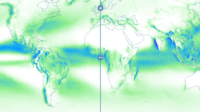
AWI, BCS-CNS and MPI-MET scientists participating in the EERIE Project will engage in several presentations at the European Geosciences Union (EGU) General Assembly in Vienna next week. This is the largest geosciences event in Europe and attracts more than 16,000 scientists from all over the world.
“Our contribution to the 2023 EGU discusses how winter rainfall could increase over Europe by around 20% in the next 30 years if greenhouse gases continue to be emitted at the current level”, explains BSC-CNS’ Eduardo Moreno-Chamarro. “This is the result of a new, much more realistic climate model (Met Office's HadGEM3-GC3.1-HH) compared to the ones commonly used for IPCC climate change assessment”.
During his presentation, Moreno-Chamarro will show that “at any lower resolution, these changes are weaker or absent, which suggest previous climate models might be underestimating future climate risks”.
His talk will also “advance the first results of STREAM, a Spanish national project aimed to study the influence of the ocean mesoscale on the European climate variability and predictability”.
Besides, MPI-MET’s Fraser Goldsworth will address the attendees on water mass transformation following instability in the mixed layer of the East Greenland Current.
In addition, AWI scientists’ contribution to the event will explore issues such as an Eddy-rich Arctic as future Sea ice disappears in high-resolution view (co-authored by Thomas Jung and Nikolay Koldunov among others) as well as the three following: Projected amplification of summer marine heatwave intensity in the Northeast Pacific Ocean in a warming world, A high-resolution view on mesoscale eddy activity in the Eurasian Basin and Evaluating nudged coupled climate models against MOSAiC observations reveals weaknesses in the representation of clouds, boundary-layer turbulence and snow pack.




